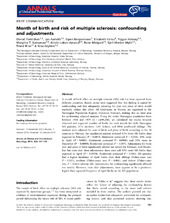| dc.contributor.author | Torkildsen, Øivind Fredvik | en_US |
| dc.contributor.author | Aarseth, Jan Harald | en_US |
| dc.contributor.author | Benjaminsen, Espen | en_US |
| dc.contributor.author | Celius, Elisabeth Gulowsen | en_US |
| dc.contributor.author | Holmøy, Trygve | en_US |
| dc.contributor.author | Kampman, Margitta Theodora | en_US |
| dc.contributor.author | Løken-Amsrud, Kristin Ingeleiv | en_US |
| dc.contributor.author | Midgard, Rune | en_US |
| dc.contributor.author | Myhr, Kjell-Morten | en_US |
| dc.contributor.author | Riise, Trond | en_US |
| dc.contributor.author | Torkildsen, Nina Agnethe Grytten | en_US |
| dc.date.accessioned | 2015-03-27T13:02:27Z | |
| dc.date.available | 2015-03-27T13:02:27Z | |
| dc.date.issued | 2014-02 | eng |
| dc.identifier.issn | 2328-9503 | |
| dc.identifier.uri | https://hdl.handle.net/1956/9687 | |
| dc.description.abstract | A month of birth effect on multiple sclerosis (MS) risk has been reported from different countries. Recent critics have suggested that this finding is caused by confounding and that adequately adjusting for year and place of birth would markedly reduce this effect. All inhabitants in Norway are registered in the Norwegian Population Registry (Statistics Norway), making this an ideal area for performing adjusted analyses. Using the entire Norwegian population born between 1930 and 1979 (n = 2,899,260), we calculated the excess between observed and expected number of births for each month for 6649 Norwegian MS patients, 5711 mothers, 5247 fathers, and 8956 unaffected siblings. The analyses were adjusted for year of birth and place of birth according to the 19 counties in Norway. An unadjusted analysis revealed 13% fewer MS births than expected in February (P = 0.0015; Bonferroni corrected P = 0.018), 10% more in April (P = 0.0083; Bonferroni corrected P = 0.0996) and 15% more in December (P = 0.00058; Bonferroni corrected P = 0.007). Adjustments for both year and place of birth significantly altered our results for February and December, but even after these adjustments there were still 10% more MS births than expected in April (P = 0.00796; Bonferroni corrected P = 0.096). MS patients had a higher incidence of April births than their siblings (Fisher-exact test; P = 0.011), mothers (Fisher-exact test; P = 0.004), and fathers (Fisher-exact test; P = 0.011) without MS. Adjustments for confounding significantly affected our results. However, even after adjustments, there appears to be a persistent higher than expected frequency of April births in the MS population. | en_US |
| dc.language.iso | eng | eng |
| dc.publisher | Wiley | eng |
| dc.rights | Attribution-NonCommercial-NoDerivs CC BY-NC-ND | eng |
| dc.rights.uri | http://creativecommons.org/licenses/by-nc-nd/3.0/ | eng |
| dc.title | Month of birth and risk of multiple sclerosis: confoundingand adjustments | en_US |
| dc.type | Peer reviewed | |
| dc.type | Journal article | |
| dc.date.updated | 2015-03-04T11:33:11Z | en_US |
| dc.description.version | publishedVersion | en_US |
| dc.rights.holder | Copyright 2014 The Authors | |
| dc.identifier.doi | https://doi.org/10.1002/acn3.37 | |
| dc.identifier.cristin | 1220659 | |
| dc.source.journal | Annals of clinical and translational neurology | |
| dc.source.40 | 1 | |
| dc.source.14 | 2 | |
| dc.source.pagenumber | 141-144 | |

